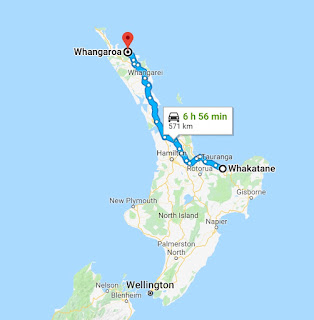so decided that might be the place for this last part of our New Zealand trip.
I had wanted to see a kiwi, so on the way north to Whangaroa we stopped at a kiwi recovery sanctuary. Kiwi's are endangered. Add in their being nocturnal, and seeing one is not that easy. You cannot capture and keep a wild kiwi, but if you are participating in a recovery program, you can raise a kiwi from an egg (they lay 2 a year) keeping them in captivity for a year when they are big enough to fend for themselves.
 |
| A real Kiwi - in a dark room (they only come out and forage at night) |
 |
| This was my backup picture if I failed in my quest. |
 |
| Kiwis lay the largest eggs of any bird. |
I also found my original quest, a Kakapo, but it was, unfortunately, stuffed. The live ones are found on just 3 protected islands where all theirpredators have been eliminated.
In Whangeroa, we found our kayaking. It was warm, clear, and windless. A great day of kayaking.
And we got in a few final swims. I continued to be amazed how warm the Pacific is this far south.
Then it was time to head back to Auckland to prepare for the long trek home. But first, on the way, we stopped for our last unique kiwi experience - a glow worm cave. Glow worms are found only in Australia and New Zealand. The glow is from the tail of the worm and is their way of attracting food (they spin a web and catch flying insects). And why are glow worms only found in NZ and Australia? Probably as their caves don't have bats (they spend the night in tress instead). If the bats lived in caves, it is likely the glow worms would have been an easy dinner.
A great trip, sad to have to leave such a great part of the world.
More pictures at https://photos.app.goo.gl/hGMakUq9NAyztNVp6








I wish you could keep on traveling and sending these wonderful, informative blogs.
ReplyDeleteI really liked the Glow Worm Caves on my first visit there. The area where you were kayaking was very beautiful!
ReplyDeleteKayaks were made for that kind scenery
ReplyDeleteLooks like you had a great trip!
ReplyDelete